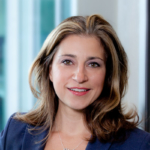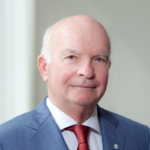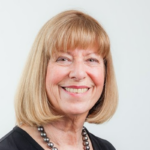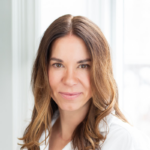As part of our ongoing Burgundy series on family philanthropy, Investment Counsellor Angela Bhutani sat down with Burgundy’s Chairman and Co-Founder Tony Arrell, his wife Anne, and their daughter Laura to discuss their path to giving as a family. They discuss their philanthropic origins, the creation and management of the Arrell Family Foundation, how responsibilities are allocated, and offer insight into selecting causes as a family.
KEY POINTS:
- Balancing personal giving priorities with common family priorities
- The need for families to customize their approach to involvement and decision-making
- The value of external expertise and ongoing learning and development
For an alternate format, access the transcript via the “Download PDF” link at the top of this post. The transcript has been edited for clarity.
Angela Bhutani: Tony and Anne, what were the origins of your giving, what prompted you to establish your family Foundation, and what advantages did the process provide your family?
Tony Arrell: I grew up in a modest family. My father worked in the juvenile court system, which exposed us to the ugly side of society. We witnessed the emotional strain of child custody cases and sympathized with people who had difficult lives. My mother went on to work as a social worker. They were always eager to help others. I believe I inherited that eagerness to help from my parents. In my life, I’ve had this overarching idea that successful people should try to improve society in some way. Anne can speak for herself, but I believe she was raised with these values, this idea of helping others.
“In my life, I’ve had this overarching idea that successful people should try to improve society in some way.”
Anne Arrell: I was raised in a giving family as well, though much more modest than Tony’s. I came from a family of six in Elmira, Ontario. My father died when I was 14 years old, and I had many younger siblings, however my mother was as generous as she could be. These origins had a big impact on my decisions later on. When it came time to establish a foundation, Tony and I were able to narrow down where we wanted to direct our giving. Tony and I made decisions in the beginning, but we later considered succession planning and involving our children. What if something happened to us while we were driving to our farm? What would we want done with our money? Talking with our children has been a valuable learning experience, especially when it comes to discussing the values that each of us hold, as their values and priorities may be different from ours. Having these discussions and the Family Foundation in place has helped us all work together for the greater good.
Angela Bhutani: Can you elaborate on the process of coming together as a family? It’s a big step to determine priorities and where your giving should go, and you decided to involve the kids in the process. Did you go through the process on your own, or did you use outside counsel?
Anne Arrell: Tony and I initially made giving decisions on our own, but once we decided to include our children, we hired a counsellor who was excellent at helping our family uncover and agree on our overall values. It was clear that some things that appealed to us did not appeal to our children. For example, Tony and I were raised to value religion, but it hasn’t been as important to our children. The same applies for the arts. Tony and I both enjoy the arts, particularly opera and the ballet. It’s not to say that Laura and her family don’t value the arts, but it’s not top of their list of charitable contributions. So, talking about our values assisted us in establishing the Foundation’s mission, which is critical to developing your mandate and deciding where you really want to focus your funds. The Foundation’s primary focus is on education and health issues, which is a broad mandate, but it does help to narrow requests. We give to causes we are personally interested in outside of the Foundation, but our family’s focus is on health and education.
Angela Bhutani: Laura, can you tell us about how you prepared for your role as the Foundation’s Managing Director?
Laura Arrell: When I was supposed to return to work after my third child, the prospect of doing so had me practically in tears. While I enjoyed my job, I was 40 years old and felt it was time for a new chapter. This happened to coincide with the growth of our Family Foundation. It had reached a point where in order to be impactful, it required more strategic oversight. Fortunately, my parents believed in me, and they were happy someone wanted to step forward and take on that responsibility. I had spent my career in the investment industry. When I switched careers to work for the Foundation, however, I was the first to admit that I didn’t know the first thing about what I was getting myself into. I knew how to analyze a balance sheet for a public company, but I had no idea how to do it for nongovernment organizations (NGOs). Because it’s in my nature, I began asking around and attempting to network. I quickly discovered what a variety of training courses are available.
Rotman School of Management at the University of Toronto offers an executive family wealth management course. Another can be found at Booth School of Business at the University of Chicago. I took them both. They are week-long courses that are not overly demanding. I would recommend them and suggest you take them with another family member to share that base knowledge. I also belong to a fantastic network called The Philanthropy Workshop, an international network of highly strategic philanthropists. It’s an ongoing annual membership that also has an intensive training component. In a three-week program, I developed a thesis and a mission and then presented it to my peers at the end. Being a member of that organization has given me an incredible network. If you want to learn more about government and how to navigate policy change effectively, you can also apply to a policy school.
“Many people are intimately involved in the areas that we are providing, and they can offer some constructive criticism and networks as well. Depending on your strategy, I believe networking in the philanthropic world is extremely important.”
Angela Bhutani: When you want to collaborate with or support an organization, what qualities or attributes do you look for?
Tony Arrell: That, I believe, is a very broad topic. I think it’s similar to: What do you invest in? Burgundy goes through a thorough research process before investing in any one company. We call it due diligence. And we pay particular attention to the people who run the business: How has the Chief Executive Officer or the board performed? Would you want to do business with these individuals? It’s similar with not-for-profits. In fact, it is even more critical in the non-profit world.
In the profit world, if a company isn’t any good and the management isn’t any good, it gets flushed out after a few years and the people are kicked out if it doesn’t do well. If the company is publicly traded, the stock price falls. However, in the non-profit world, this is not always the case. People can sort of limp along in the non-profit world and survive because they may be supported by the government, have a large number of donors, or whatever. So, I’d say that in the non-profit world, where we donate, we try to use some of those ideas. We’ve made a lot of mistakes, but I believe some of the most successful things we’ve done were because the organizations had a really good mission and we liked who was running it and possibly who was on the board.
Angela Bhutani: Is accountability an issue as well?
Tony Arrell: Without a doubt. We want to see quality reporting. We always examine the financial statements of organizations.
Laura Arrell: The balance sheet is crucial in our analysis. In addition, for many of the projects we’ve completed, we’ve insisted on the formation of an advisory committee. The Arrell Food Institute is a prime example of this. We insist on taking a seat or having a couple of seats available for people we nominate, and they can choose whether to accept them. That has been useful in that we now feel involved and have a voice if we are dissatisfied with something.
Angela Bhutani: Could you please elaborate on the advisory committee? Is it primarily made up of subject-matter experts?
Laura Arrell: The committees I’m referring to are the organizations themselves, but we now have our own advisory committee for the Family Foundation comprised of three people, including the ex-President of the University of Guelph. Many people are intimately involved in the areas that we are providing, and they can offer some constructive criticism and networks as well. Depending on your strategy, I believe networking in the philanthropic world is extremely important. Coming together with coalitions of sorts from all over the country in the areas you’re giving has also been a very useful tool for us.
Q: How do you handle the disconnect between the parents’ and the younger generation’s perspectives in a multi-generational family when you’re both trying to accomplish something?
Tony Arrell: You just sort of compromise, like everything in life. Laura is interested in a couple of things where I am not. We try to reach an agreement. We also have a few ground rules. Each of our three daughters can contribute a certain amount to causes that are important to them. As a result, there is room for differences. Frankly, I think that disagreement is healthy.
Laura Arrell: I agree. Luckily, we do get along well. I think that having an outside voice in the room has been effective. We have a moderator, but he has been more of a facilitator, and that has really helped professionalize the conversation. When there is family at the table, family dynamics are bound to arise. I think we have benefitted from having this advisory committee and professionals with diverse perspectives.
Angela Bhutani: Anne, two of your daughters live in the United States. How do you move things forward when it comes to getting everyone together and making decisions?
Anne Arrell: Tools like Zoom have completely transformed our lives and become a part of our routine. If you believe that everyone in your family will contribute equally, realize that this is not the case in practice. We’ve seen many family organizations with less-engaged members, but it’s critical for them to feel like they’re a part of the decision-making process. We have two daughters living in the United States who are not present for all meetings and decisions. By establishing an executive committee comprised of the three of us (Tony, Laura, and me), we can move key decisions forward. We meet once a month to discuss Laura’s activities. In addition to our monthly meetings, we also have a semiannual formal meeting.
Q: Hopefully, three generations will be involved at some point. Laura, will you do things the same way or differently with your own children, and when do you think you should start?
Laura Arrell: We haven’t really talked about it much. My husband Erik and I are hoping that our children will receive the giving-back philosophy through osmosis, and we are already seeing signs of it. My eldest is 15 years old, so I don’t think we’re there yet. But I’m hoping that by the time they are of age, we’ll have a more formalized process to bring in that next generation. Many foundations are deliberate in this process. I think we are on the verge of allowing them to attend board meetings but not yet vote. In our case, I believe it’s too early, but I certainly hope they will be actively engaged.
There have also been discussions in our family that it’s not your right to be there. You must earn the right. So, I think you must demonstrate this to family members. Allowing for smaller donations, in my opinion, could be a useful tool for assisting the next generation. Ask them to write a thesis about why they want to support this organization and how they intend to participate actively. According to what I’ve heard from other organizations, this is an effective tool.
“If you believe that everyone in your family will contribute equally, realize that this is not the case in practice[…]but it’s critical for them to feel like they’re a part of the decision-making process.”
Tony Arrell: What you really want is for them to grow up with the right values. If you have the right values, the rest is trivial. Successful people do not want to raise a generation of entitled children. We spent quite a bit of time planning, holding meetings at our Foundation with our other children, and asking them what their values are. It’s an ethereal topic. I believe that companies should do a better job with stating their values. Mission statements are common in businesses. Families, on the other hand, don’t have the luxury. But I think we have made progress here. My hope for my grandchildren is that they will have good humanitarian ideas to help make the world a better place.
Laura Arrell: Related to this, my siblings and I asked our parents to write a memorandum of values to be passed down to the future family. We wrote our own as well. Having what we hope to achieve in writing keeps it from disappearing in the future.
Angela Bhutani: Getting to know each of you better and learning about what you’ve done behind the scenes has been extremely rewarding. Many of the same success factors that apply to business apply to managing a foundation. That is, starting with a discussion of values, allowing everyone to have a seat at the table, encouraging engagement, and, lastly, considering succession planning. I hope your experience can be useful to other families. Thank you.![]()
This post is presented for illustrative and discussion purposes only. It is not intended to provide investment advice and does not consider unique objectives, constraints or financial needs. Under no circumstances does this post suggest that you should time the market in any way or make investment decisions based on the content. Select securities may be used as examples to illustrate Burgundy’s investment philosophy. Burgundy funds or portfolios may or may not hold such securities for the whole demonstrated period. Investors are advised that their investments are not guaranteed, their values change frequently and past performance may not be repeated. This post is not intended as an offer to invest in any investment strategy presented by Burgundy. The information contained in this post is the opinion of Burgundy Asset Management and/or its employees as of the date of the post and is subject to change without notice. Please refer to the Legal section of this website for additional information.





